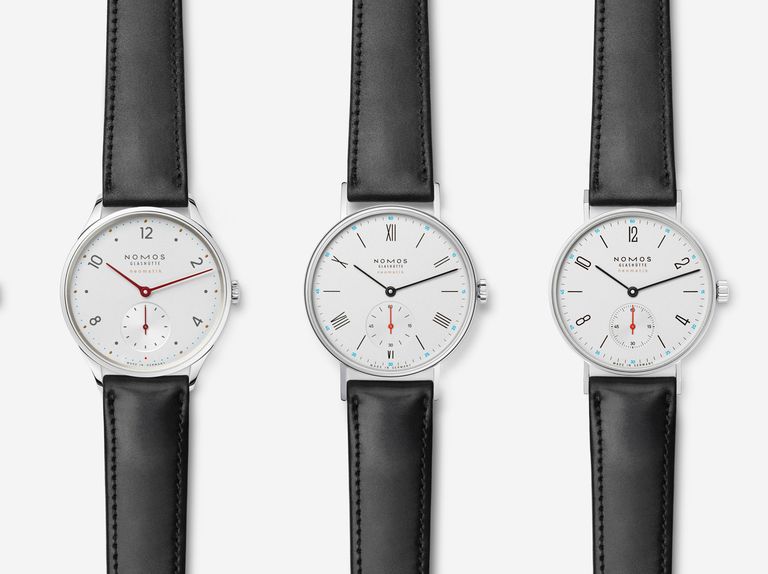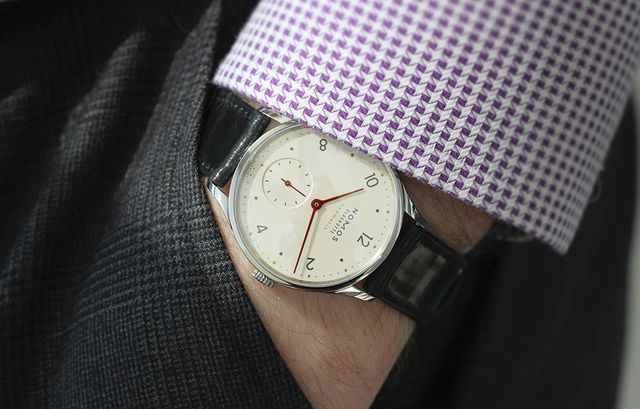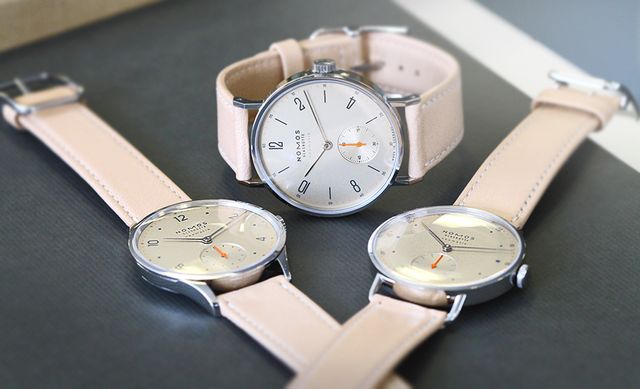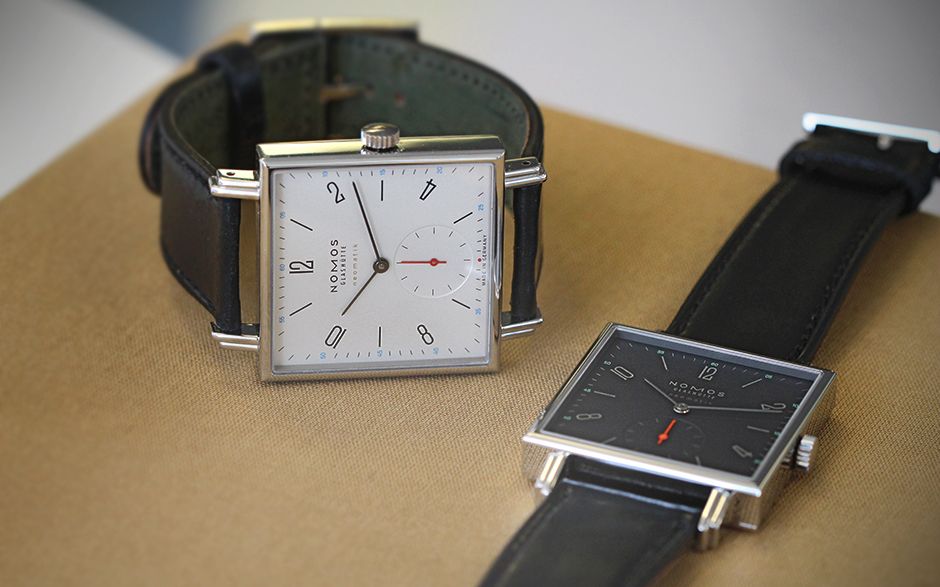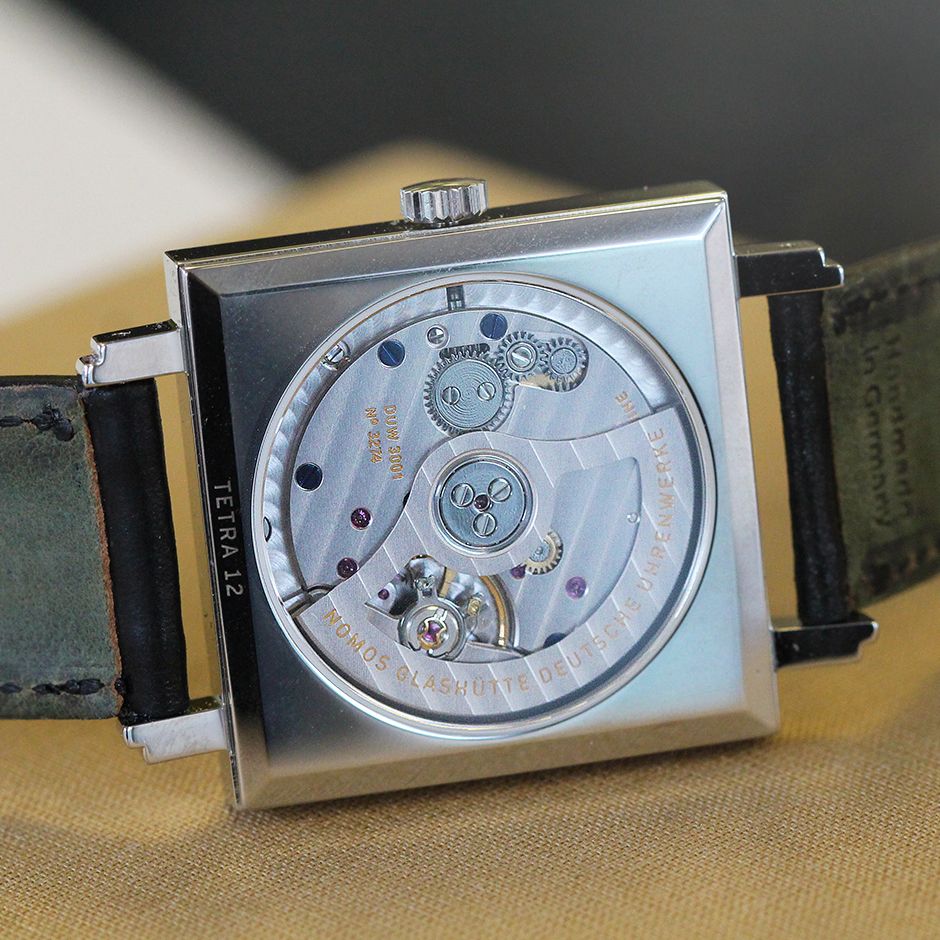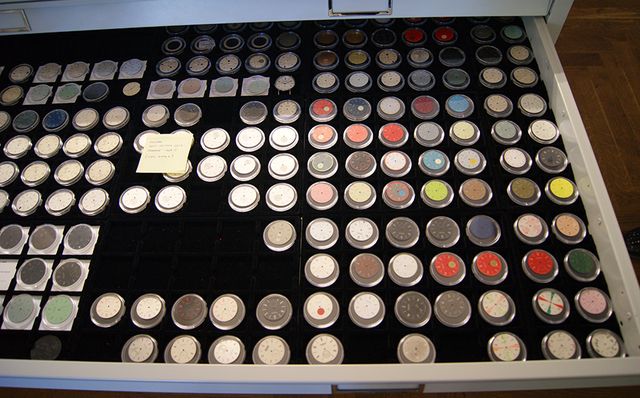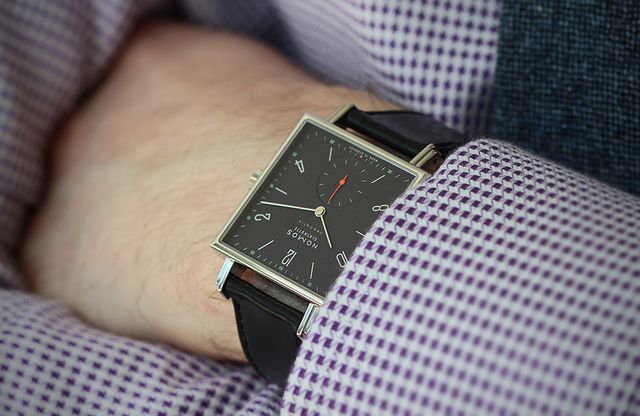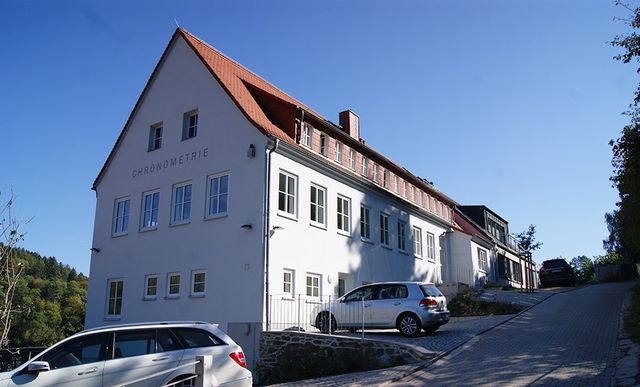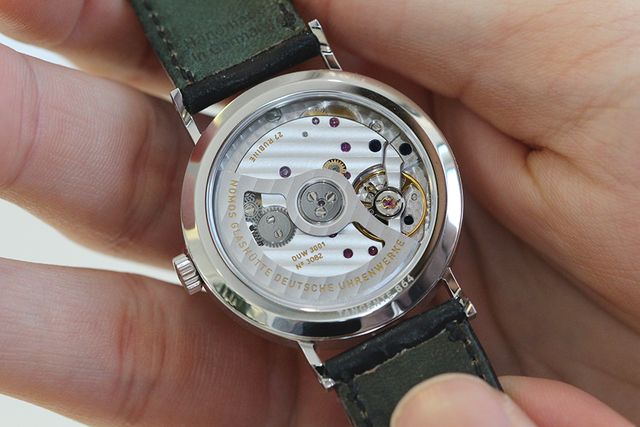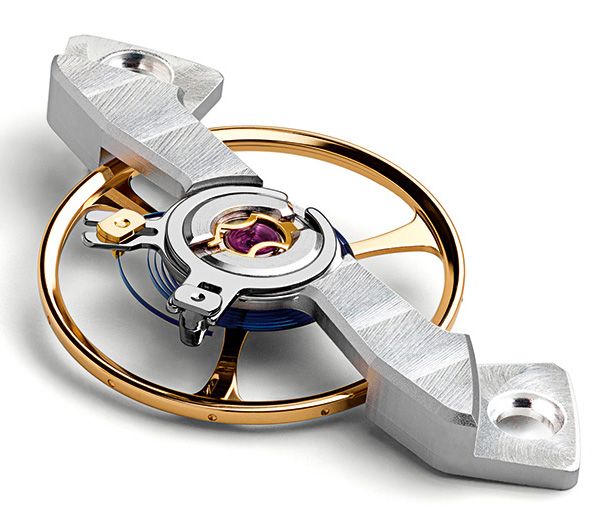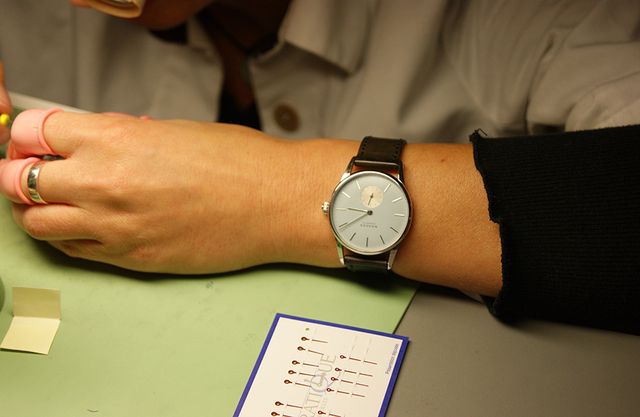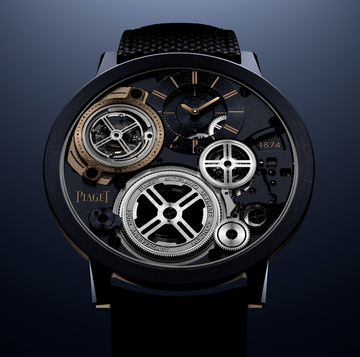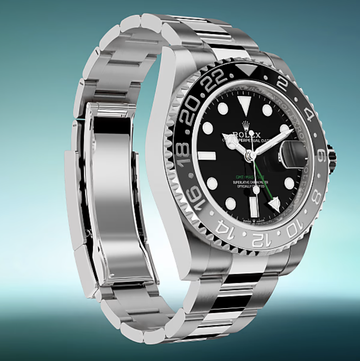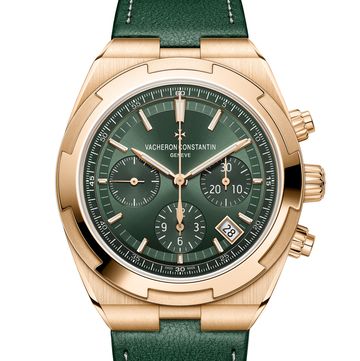Nomos Glashütte CEO Uwe Ahrendt is describing the step change that the brand’s latest range, the Neomatik, signifies. It’s a serious statement coming from a company that, as he puts it, “prefers to make the same clean and simple watches and movements every year, and tries to increase the quality day by day, year by year.”
We’re familiar with Nomos’ quality, offering smartly modern in-house watches at remarkable value, between £1,000 and £4,000. But all those little daily changes add up, and recently they have started to snowball.
Two years have passed since the announcement of the Swing System, Nomos’ in-house escapement, and now we are in a position to see the bigger picture. At Baselworld last year, it launched the Nomos Minimatik; a youthful, colour-speckled 35mm watch that, we were told, was the shape of things to come. It housed Nomos caliber DUW 3001, an all-new, ultra-slim automatic movement – it’s thinner even than the caliber powering Jaeger-LeCoultre’s Master Ultra Thin – complete with Swing System. Presented alongside it was a watch Nomos was then calling the Tangente Automatik. Also using the DUW 3001, it was a lightly-breathed-upon 35mm Tangente, whose dabs of extra colour hinted at a hitherto unseen flexibility to the brand’s flagship design.
In fact, this was merely an icebreaker for the full Neomatik collection, which came along six months later and included that juiced-up Tangente, the Minimatik and much more.
My name is Neo
The Neomatik collection, and the caliber that powers it, are at the forefront of the biggest shift in priorities Nomos has undergone. Its impact, most significantly, will be to erode the clear majority that manual-wind watches currently enjoy, moving Nomos’ output to an eventual 50-50 split. Couple that with a younger, breezier appeal to both sexes, and the ambition to break away from dependence on local markets (60 per cent of business is done in Germany; 70 per cent in Europe overall), and the message is one of widening horizons. It’s also one of a greater sense of fun (albeit in a typically Germanic, restrained sort of way).
The Neomatik is easily the most sweeping change made by the brand in years, but explaining what it is, specifically, can tie you in knots a little bit. It’s not a new family of watches – rather, it’s a style, an interpretation of five of the core Nomos families: Tangente, Metro, Ludwig, Orion and Tetra. Each of these designs has been given the Neomatik treatment, which means the creation of two new references per family, usually one with a white dial and blue, red or orange detailing, and one with a champagne-coloured dial and orange accents. These four pairs are referred to as the “Tangente Neomatik”, or “Ludwig Neomatik champagner”, and so on.
The Neomatik line-up also includes the Minimatik, largely unchanged. Since no non-Neomatik versions of the Minimatik exist, it’s tautological to call it the “Minimatik Neomatik” (which sounds more like a Kraftwerk song than a watch), though it does say Neomatik on the dial. Most crucially, every Neomatik uses the new DUW 3001 movement, and all are sized between 35mm and 36mm.
The ten Neomatiks released last October, it now transpires, are not hanging around. Referred to now as “Neomatik 1st edition” and produced in unspecified numbers, production is set to close shortly before Baselworld 2016 to make way for the second (and final) non-limited edition . The differences are exceedingly subtle visually – tiny tweaks of typography and colours – but signify an improved version of the Swing System, allowing more precise hairspring adjustment.
The square Tetra is the latest to receive the Neomatik treatment, meanwhile; the effect isn’t as pronounced, since unlike the other models, Tetra already had a few bright dial colours – but we do get a lovely “tiefblau” dial with green and orange details, and the new DUW 3001 movement.
So why is this important? Why the millions of euros poured into R&D, the addition of new automatic models to collections that already had automatic models, the application of new terminology and the declaration that all this points to a bold new future for Nomos Glashutte? Just what does Nomos 2.0 mean?
Well, on the one hand you can read it simply as a design thing: Nomos is injecting a deeper sense of fun and style into its dials, though it’s a quality that has always been present when you look hard enough.
In fact, if visiting Nomos – both the design studio in Berlin and the manufacture in Glashütte – is not quite a raucous experience, compared to most watch brands it’s a Bangkok street market of colour and light.
In Berlin, ten-foot prints of Tetra dials in every colour imaginable hang on the walls alongside a neon sign that reads “Ahoi Glashütte!” In the factory, there are faux-retro 1930s motivational posters with slogans such as “Machine care is as important as care of the body”. Elsewhere are professional photographs of watchmakers alongside miniature “sculptures” that each has made with the blue-green Rodico putty found on every workbench.
Open a drawer in Berlin and you can find a smorgasbord of prototype dial patterns: everything from Japanese cherry blossom to crosshatched and sector dials. Some of these are what the staff know as “Christmas watches”; every year, every worker receives a watch with a non-retail dial pattern. A sky-blue Orion with white small-seconds was one that I spotted on a watchmaker’s wrist - you can see this money-can't-buy Nomos at the bottom of this post.
In recent years, more and more of that personality and colour has been seeping out. We saw it in the name Nomos gave its swimming watch – “Ahoi!” – and the fact, let’s face it, that it brought out a swimming watch (with locker key strap) rather than a diver. We see it in the brand’s blurb, usually refreshingly free of jargon, and in its healthy sideline in quirky accessories: a pendant necklace that doubles as a sundial (described as the “lowest-priced Nomos caliber”) and a wryly amusing encyclopaedia of Glashütte.
As designer Thomas Hohnel says, “Nomos was never meant to be about pure intellectualism – we’re always being compared with Bauhaus, but we’ve always seen ourselves as more playful than that.” Only recently did this cheeky zest start extending more boldly to the watches themselves, via the Ahoi and Metro models, and the colourful experimentalism of the the high-end Lux and Lambda.
Neomatik takes this mainstream. It is the translation of those experimental dials in the manufacture drawer into a specific style that’s modern, bright, positive and interesting, without shedding the clinical restraint that’s so crucial to Nomos. As Ahrendt says, tongue firmly in cheek, “We have no George Clooney. We don’t make watches for people with big cars, or big houses. We make watches for people who can read and write.”
Two decades of progress
But of course, it’s what’s inside the Neomatik that really counts. It’s easy to reel off the milestone achievements of Nomos in its 23-year history and not think too much about what they entailed. Founded in 1990, it had at its heart the aim to produce its own movements long before ETA began turning off the taps, and after 15 years debuted the Alpha caliber. The next decade saw a further 13 calibers join the roster, and an investment of £9 million just in creating the Swing System. Along the way it proved it could compete at an haute horlogerie level, with Lux and Lambda. All of which has been accompanied by a boom in numbers: Nomos won’t disclose its official production figures, but it surpassed the 10,000 a year mark a while ago, while staff numbers have doubled between 2011 and 2014, to around 200.
Let’s just go back to the Swing System, briefly. The inception of Nomos’ in-house escapement was covered in detail in QP in 2014, but some details bear reflection. The project began at square zero; almost nothing was bought in (barring the hairsprings, which are sourced from a German provider), to the extent that Nomos even developed its own software for measuring the accuracy of each escapement, and to help watchmakers pair springs with balances – a highly demanding skill.
The same meticulous approach was taken in the development of the DUW 3001. Nomos did already have an automatic movement on the books – the Epsilon, which powers the Tangomat and others – but its relative bulk (4.3mm thick, 31mm in diameter) was becoming incompatible with the desire to make slim, small automatic watches. So, work began on a new movement, headed up by Theo Prenzel, Nomos’s assiduous deputy head of movement design.
Despite the imperative to create a slimline movement, Prenzel was emphatic that the DUW 3001 had to prove itself on grounds other than size. It had to achieve chronometer levels of accuracy, and not cost more than other Nomos calibers to produce. And it needed equivalent power reserves to Nomos’ existing automatic base caliber, the Epsilon.
In the end, the DUW 3001 measures just 3.2mm thick and 28.8mm across. The power reserve comes in at 42 hours (Epsilon’s is 43). More impressive, however, is the way it has been achieved: reluctant to consider workarounds like micro-rotors (partly because the necessary architecture makes it harder to accommodate Nomos’s signature small-seconds), Prenzel set about the ruthless pursuit of efficiency.
Devil in the detail
It may not be the stuff that keeps most of us up at night, but you have to admire it. This is the watch world’s equivalent of stripping excess weight from a Le Mans car in search of precious tenths of a second per lap, shrinking the whole while maintaining the power. Nomos claims the DUW 3001 is 94 per cent efficient over all, thanks to a re-worked gear train; it also gains power more efficiently thanks to an all-new twin pawl winding wheel.
Whereas the average ETA or Rolex tractor has an effective winding angle (the distance the rotor has to rotate before it begins to transmit power to the mainspring) of around 40 degrees (20 in either direction), DUW 3001’s is just 10 – so, the slightest movement and it’s up and running. Consequently, after an hour of rotor movement, Nomos’s new engine has 23 ½ hours of power stored up, versus 21 for a Rolex 3135 or 17 ¾ for an ETA 2824 or 2893. (Gone too are the Greek movement names, in favour of duller designations for serious volume production – but you can’t have everything.)
All of which points at a vigorous and commercially critical few years ahead. Which is why, when I ask CEO Uwe Ahrendt what his main concerns are for the next 10 years, his answer is refreshing: “I hope that Nomos is more international, of course. But I also hope that we have the same fun that we do now and that we can continue to find a good work-life balance for all our employees.”
We can also report – disappointingly for many – that one thing the future reportedly does not hold is a move into more complicated watchmaking. For now at least, there will be no Nomos chronograph, or calendar watches. But much as we’d love to see both, it’s hard to begrudge Nomos Glashütte this decision. Under Ahrendt, the overriding impression is of a brand that truly knows its own mind – which is rare enough, in this industry. Maybe by the time we get to Nomos 3.0...
